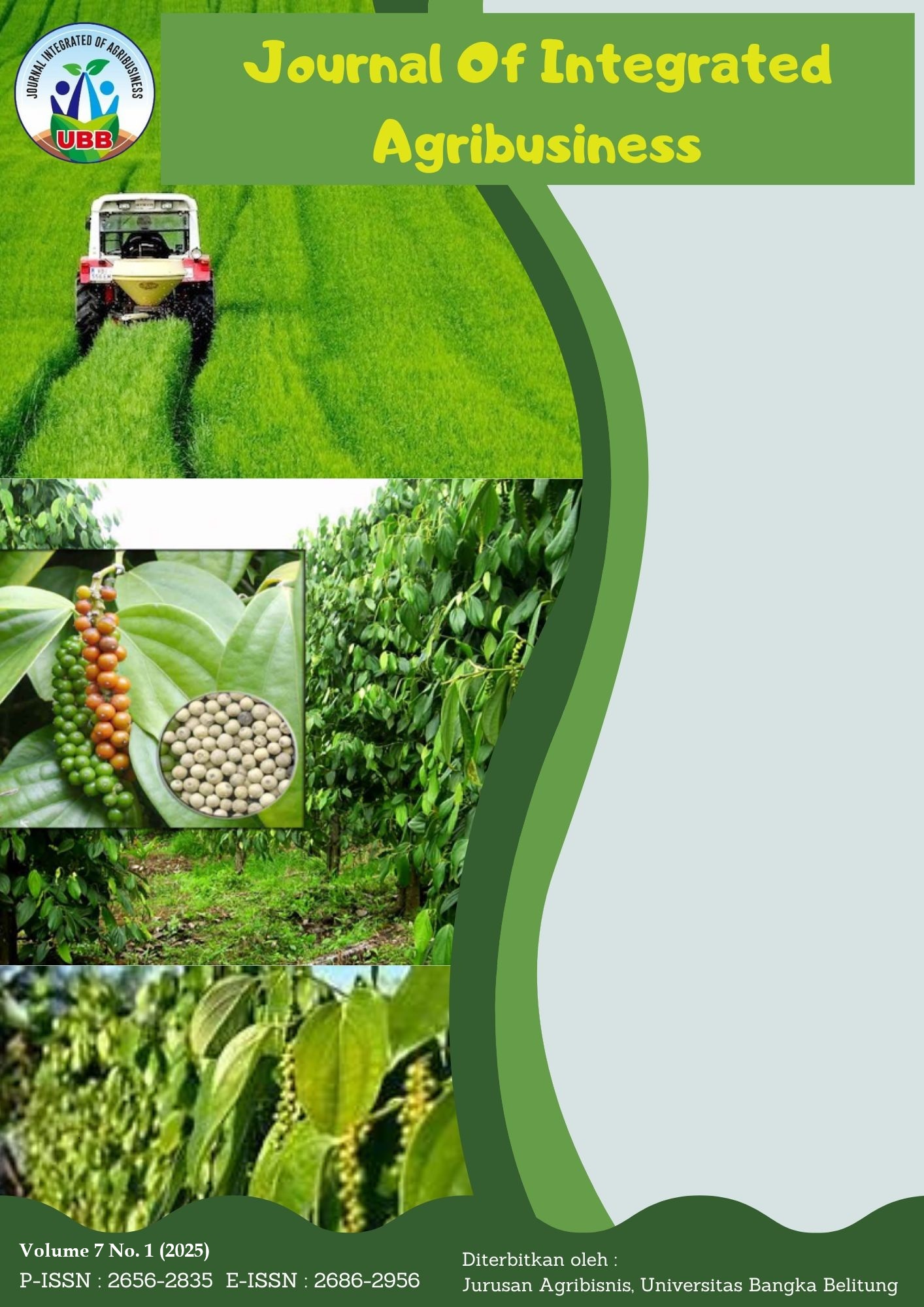Participation of Farmer Groups in Rice Farming Activities to Support Sustainable Agriculture
Partisipasi Kelompok Tani dalam Kegiatan Usahatani Padi untuk Mendukung Pertanian Berkelanjutan
DOI:
https://doi.org/10.33019/jia.v7i1.6186Keywords:
Economic Sustainability, Environmental Sustainability, Farmer Groups, Participation, Sustainable AgricultureAbstract
Farmer involvement refers to the active participation of individual farmers or farmer collectives in decision-making processes with awareness and intention. This study examines the extent of farmer engagement in sustainable agricultural practices. Descriptive statistics were used to profile respondents, while the Structural Equation Modeling (SEM) approach was applied to assess the effect of participation in farmer groups on sustainable agriculture. Sixty rice farmers were selected as respondents using the Slovin formula. The research was conducted in the Secanggang District, Langkat Regency, a key rice-producing area deliberately chosen as the study site. Primary data were collected through a structured questionnaire. The analysis revealed that among the three dimensions of sustainability, social, economic, and environmental, only the financial and ecological aspects showed statistically significant effects, with coefficients of 0.398 and 0.502, respectively. Farmer participation in evaluation and implementation processes contributed positively to advancing sustainable agricultural practices. Strengthening farmer groups should be prioritized by government agencies and academic institutions, with efforts directed toward enhancing human resource capacity in areas such as institutional management, market network expansion, partnership development, capital strengthening, and information technology training.
Downloads
References
Chin, W. W. (1998). The partial least squares approach to structural equation modeling. In G. A. Marcoulides (Ed.), Modern methods for business research (pp. 295–336). Lawrence Erlbaum Associates.
Chin, W. W., & Todd, P. A. (1995). On the use, usefulness, and ease of use of structural equation modeling in MIS research: A note of caution. MIS Quarterly, 19(2), 237–246. https://doi.org/10.2307/249690
Effendy, L. (2020). Model pengembangan kelembagaan petani menuju kelembagaan ekonomi petani di Kecamatan Sindangkasih Ciamis. Jurnal Ekonomi Pembangunan STIE Muhammadiyah Palopo, 6(1), 1–14. https://doi.org/10.35906/jep01.v6i1.492
Elizabeth, R. G. (2019). Peningkatan partisipasi petani, pemberdayaan kelembagaan dan kearifan lokal mendukung ketahanan pangan berkelanjutan. Agricore: Jurnal Agribisnis dan Sosial Ekonomi Pertanian Universitas Padjadjaran, 4(2), 157–166. https://doi.org/10.24198/agricore.v4i2.26509
Fornell, C., & Larcker, D. F. (1981). Evaluating structural equation models with unobservable variables and measurement error. Journal of Marketing Research, 18(1), 39–50. https://doi.org/10.1177/002224378101800104
Garson, G. D. (2016). Partial least squares: Regression & structural equation models. Statistical Associates Publishers.
Hasanuddin, T., Viantimala, B., & Fitriyani, A. (2021). Kinerja penyuluh pertanian lapangan, kepuasan petani, dan produktivitas usahatani jagung di Kecamatan Natar, Kabupaten Lampung Selatan. Suluh Pembangunan: Journal of Extension and Development, 3(2), 13–21. https://doi.org/10.23960/jsp.vol1.no2.2019.25
Höck, M., & Ringle, C. M. (2006, September 28–30). Strategic networks in the software industry: An empirical analysis of the value continuum. In Proceedings of the IFSAM VIIIth World Congress. IFSAM.
Holle, Y. (2022). Penguatan kelembagaan kelompok tani untuk meningkatkan posisi tawar petani. Sosio Agri Papua, 11(1), 27–36. https://doi.org/10.30862/sap.v11i01.253
Insani, F. R., Setiawan, I., & Rasiska, S. (2018). Determinan partisipasi dan peran petani muda dalam pengembangan pertanian ramah lingkungan di Desa Cisondari, Kecamatan Ciwidey, Kabupaten Bandung, Jawa Barat. Mimbar Agribisnis: Jurnal Pemikiran Masyarakat Ilmiah Berwawasan Agribisnis, 4(2), 131–144. https://doi.org/10.25157/ma.v4i2.1133
Irawan, N. C. (2023). Farmers’ perceptions of extension officers’ role in the Agricultural Development Strategy Command (KOSTRATANI) program. Jurnal Triton, 14(2), 101–110. https://doi.org/10.47687/jt.v14i2.509
Konyep, S. (2020). Upaya pencapaian swasembada pangan melalui membumikan padi amfibi Balitbangtan di Provinsi Papua Barat. Jurnal Triton, 11(2), 79–88. https://doi.org/10.47687/jt.v11i2.115
Maulida, N. S., Nuryaman, H., & Mutiarasari, N. R. (2022). Hubungan antara peran penyuluh pertanian dan partisipasi petani dengan produktivitas kerja petani minapadi. Mahatani: Jurnal Agribisnis (Agribusiness and Agricultural Economics Journal), 5(2), 166–175. https://doi.org/10.52434/mja.v5i2.2094
Muniarty, P., Wulandari, W., Pratiwi, A., Kusumayadi, F., & Haryanti, I. (2021). Penguatan partisipasi petani melalui penyuluhan pertanian di Kecamatan Rasanae Timur Kota Bima. Global Abdimas: Jurnal Pengabdian Masyarakat, 1(1), 25–33. https://doi.org/10.51577/globalabdimas.v1i1.77
Ngadi, & Noveria, M. (2017). Keberlanjutan perkebunan kelapa sawit di Indonesia dan prospek pengembangan di kawasan perbatasan. Masyarakat Indonesia, 43(1), 73–90.
Nurhafsah, N., H., R., Andriani, I., & Fitriawaty, F. (2021). Analisis usahatani cabai di luar musim berdasarkan penerapan komponen budidaya cabai merah di Provinsi Sulawesi Barat. Jurnal Teknotan, 15(1), 8–17. https://doi.org/10.24198/jt.vol15n1.2
Puspitaningsih, O. S., Utami, B. W., & Wijianto, A. (2018). Partisipasi kelompok tani dalam mendukung program-program pertanian berkelanjutan di Kecamatan Puring, Kabupaten Kebumen (Studi komparasi kelompok tani kelas lanjut dan pemula). Caraka Tani: Journal of Sustainable Agriculture, 31(2), 139–148. https://doi.org/10.20961/carakatani.v31i2.11950
Sebayang, V. B., Sastrawan, U., Firmansyah, I., & Sitepu, R. K. K. (2022). Efisiensi produksi usahatani seledri di Kabupaten Cianjur: Stochastic frontier analysis. Mahatani: Jurnal Agribisnis (Agribusiness and Agricultural Economics Journal), 5(2), 136–145. https://doi.org/10.52434/mja.v5i2.1982
Sitepu, R. K. K., & Sebayang, V. B. (2023). Household decisions in implementing urban farming. Journal of Agribusiness and Agricultural Communication, 6(1), 1–13.
Sugino, S. (2021). Analisis faktor-faktor yang mempengaruhi motivasi penyuluh pertanian di era revolusi industri 4.0. Agromix, 12(1), 1–12. https://doi.org/10.35891/agx.v12i1.2140
Sukmayanto, M., Listiana, I., & Hasanuddin, T. (2022). Analisis produksi dan pendapatan usahatani padi di Kabupaten Lampung Tengah. Jurnal Ekonomi Pertanian dan Agribisnis, 6(2), 364–377. https://doi.org/10.21776/ub.jepa.2022.006.02.26
Sulaiman, A. A., Subagyono, K., Soetopo, D., Sulihanti, S., & Wulandari, S. (2018). Kebijakan penyelamat swasembada pangan (Edisi ke-2). IAARD Press (Indonesian Agency for Agricultural Research and Development).
Syofian, S., Sujianto, S., & Handoko, T. (2020). Modal sosial kelembagaan petani karet di Kabupaten Kuantan Singingi. Gulawentah: Jurnal Studi Sosial, 5(1), 48–55. https://doi.org/10.25273/gulawentah.v5i1.6388
Zogar, A. U., Retang, E. K., & Djoh, D. A. (2022). Peran kelompok tani terhadap produktivitas usahatani padi sawah di Desa Palakahembi Kecamatan Pandawai. Jurnal Ilmiah Mahasiswa Agroinfo Galuh, 9(2), 417–425.
Downloads
Published
Issue
Section
License
Copyright (c) 2025 Budi Silaban, Mhd Asaad, Rasidin Karo Karo Sitepu

This work is licensed under a Creative Commons Attribution-NonCommercial 4.0 International License.










